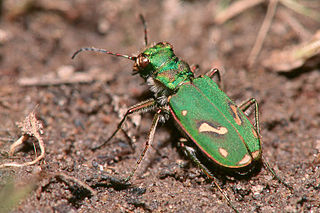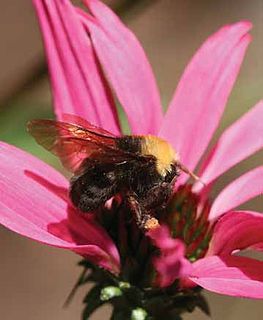
The Hawaiian crow or ʻAlalā is a species of bird in the crow family, Corvidae, that is currently extinct in the wild, though reintroduction programs are underway. It is about the size of the carrion crow at 48–50 centimetres (19–20 in) in length, but with more rounded wings and a much thicker bill. It has soft, brownish-black plumage and long, bristly throat feathers; the feet, legs and bill are black. Today, the Hawaiian crow is considered the most endangered of the family Corvidae. They are recorded to have lived up to 18 years in the wild, and 28 years in captivity. Some Native Hawaiians consider the Hawaiian crow an ʻaumakua.

Yellowjacket or yellow jacket is the common name in North America for predatory social wasps of the genera Vespula and Dolichovespula. Members of these genera are known simply as "wasps" in other English-speaking countries. Most of these are black and yellow like the eastern yellowjacket Vespula maculifrons and the aerial yellowjacket Dolichovespula arenaria; some are black and white like the bald-faced hornet, Dolichovespula maculata. Others may have the abdomen background color red instead of black. They can be identified by their distinctive markings, their occurrence only in colonies, and a characteristic, rapid, side-to-side flight pattern prior to landing. All females are capable of stinging. Yellowjackets are important predators of pest insects.
Located about 2300 miles (3680 km) from the nearest continental shore, the Hawaiian Islands are the most isolated group of islands on the planet. The plant and animal life of the Hawaiian archipelago is the result of early, very infrequent colonizations of arriving species and the slow evolution of those species—in isolation from the rest of the world's flora and fauna—over a period of at least 5 million years. As a consequence, Hawai'i is home to a large number of endemic species. The radiation of species described by Charles Darwin in the Galapagos Islands which was critical to the formulation of his theory of evolution is far exceeded in the more isolated Hawaiian Islands.

The mountain yellow-legged frog, also known as the southern mountain yellow-legged frog, is a species of true frog endemic to California in the United States. It occurs in the San Jacinto Mountains, San Bernardino Mountains, and San Gabriel Mountains in Southern California and the Southern Sierra Nevada. It is a federally listed endangered species.

Hylaeus is a large and diverse cosmopolitan genus within the bee family Colletidae.

Moʻomomi is a Nature Conservancy preserve located on the northwestern shore of Molakaʻi in Hawaii. It was established in 1988. This area is dry and hot, primarily denuded of soil due to overgrazing and poor land use practices over the last 150 years.

Hylaeus alcyoneus, commonly known as the banksia bee, is a bee species endemic to Australia where it is commonly found in the coastal heaths of eastern and southern Western Australia. This bee is an important pollinator of Banksia species.

The Ohlone tiger beetle, Cicindela ohlone, is endemic to California. It was discovered in 1987 and named and described in 1993. C. ohlone is part of the genus Cicindela and is most closely related to C. purpurea.

The environment of the United States comprises diverse biotas, climates, and geologies. Environmental regulations and the environmental movement have emerged to respond to the various threats to the environment.

The Carson–Iceberg Wilderness is a federal wilderness area located 80 miles (130 km) northeast of Stockton, California. It encompasses 160,000 acres (650 km2) and was designated by the California Wilderness Act of 1984. It protects an area of High Sierra landscape with elevations from 4,800 feet (1,500 m) to 11,462 feet (3,494 m) along the Sierra Mountains from Ebbetts Pass to Sonora Pass in the south. The US Forest Service manages the wilderness which is in both the Stanislaus National Forest and the Humboldt–Toiyabe National Forest.

Argyroxiphium sandwicense subsp. sandwicense, the Mauna Kea silversword, is a highly endangered flowering plant endemic to the island of Hawaiʻi of Hawaii. It is the "crown jewel" of the volcanic mountain Mauna Kea, from which it derives its English name. The Hawaiian name is ʻahinahina; it applies to silverswords more broadly. The Mauna Kea silversword was once common on the volcano, and extraordinary conservation efforts are being made to preserve the species.

Franklin's bumblebee is known to be one of the most narrowly distributed bumblebee species, making it a critically endangered bee of the western United States. It is known only from a 190-by-70-mile area in southern Oregon and northern California, between the Coast and Sierra-Cascade mountain ranges. It was last seen in 2006. Franklin's bumblebee is known to collect nectar and pollen from several wildflowers, such as lupine, California poppy, and horsemint, which causes it to be classified as a generalist forager.
Hylaeus longiceps is a species of bee, also known by the common names longhead yellow-faced bee or Hawaiian yellow-faced bee. It is endemic to Hawaii and known from only six populations. In September 2016, along with six other Hawaiian bee species, H. longiceps was listed for protection under the United States Endangered Species Act. This marked a first listing for any bees species in the US.
Hylaeus anthracinus is a species of bee, also known by the common name anthricinan yellow-faced bee. It is endemic to Hawaii and known from only 16 populations. In September 2016, along with six other Hawaiian Hylaeus species, H. anthracinus was listed for protection under the United States Endangered Species Act. This marked a first listing for any bee species in the US.
Hylaeus assimulans is a species of bee, also known by the common name Assimulans yellow-faced bee. It is endemic to Hawaii and known from only five populations. In September 2016, along with six other Hawaiian Hylaeus species, H. assimulans was listed for protection under the United States Endangered Species Act. This marked a first listing for any bee species in the US.
Hylaeus facilis is a species of bee, also known by the common name easy yellow-faced bee. It is endemic to Hawaii and known from only two populations. In September 2016, along with six other Hawaiian Hylaeus species, H. facilis was listed for protection under the United States Endangered Species Act. This marked a first listing for any bee species in the US.
Hylaeus kuakea is a species of bee, also known by the common name Hawaiian yellow-faced bee. It is endemic to Hawaii and known from only two populations. In September 2016, H. kuakea and six other Hawaiian Hylaeus species were listed for protection under the United States Endangered Species Act. This marked a first listing for any bee species in the US.
Hylaeus mana is a species of bee, also known by the common name Hawaiian yellow-faced bee. It is endemic to Hawaii and known from only four populations. In September 2016, along with six other Hawaiian Hylaeus species, H. mana was listed for protection under the United States Endangered Species Act. This marked a first listing for any bee species in the US.

Hylaeus agilis, commonly known as the Agile masked bee, is a bee species in the family Colletidae. It is endemic to New Zealand. This species is found throughout the country and visits the flowers of a wide variety of plant species, both native and introduced.

Hylaeus relegatus, also known as the Māori masked bee, is a bee species in the family Colletidae. It is endemic to New Zealand and was first described by Frederick Smith. It is the largest and most common species of this genus in that country. H. relegatus can be found throughout the three main islands of New Zealand and visits the flowers of a wide variety of plant species, both native and introduced. Although widespread, this species is not abundant at any one particular location. It has been hypothesised that human made nest sites can be used to increase its numbers.













